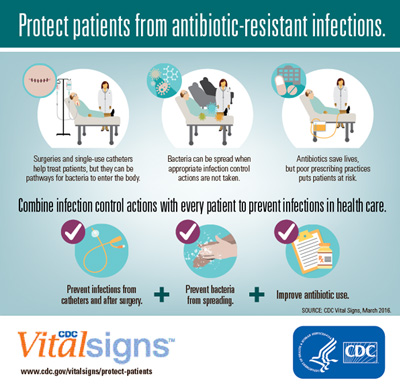by Brianna Crandall — March 9, 2016—America is doing a better job of preventing healthcare-associated infections (HAIs), but more work is needed — especially in fighting antibiotic-resistant bacteria. The U.S. Centers for Disease Control and Prevention’s (CDC) latest Vital Signs report urges healthcare workers to use a combination of infection control recommendations (see the CDC infographic) to better protect patients from these infections.
CDC Director Tom Frieden, M.D., M.P.H., pointed out:
New data show that far too many patients are getting infected with dangerous, drug-resistant bacteria in healthcare settings. Doctors and healthcare facilities have the power to protect patients — no one should get sick while trying to get well.
Many of the most urgent and serious antibiotic-resistant bacteria threaten patients while they are being treated in healthcare facilities for other conditions, and may lead to sepsis or death. In acute care hospitals, one in seven catheter- and surgery-related HAIs can be caused by any of the six antibiotic-resistant bacteria listed below. That number increases to one in four infections in long-term acute care hospitals, which treat patients who are generally very sick and stay, on average, more than 25 days.
The six antibiotic-resistant threats examined are:
- Carbapenem-resistant Enterobacteriaceae (CRE)
- Methicillin-resistant Staphylococcus aureus (MRSA)
- ESBL-producing Enterobacteriaceae (extended-spectrum β-lactamases)
- Vancomycin-resistant Enterococcus (VRE)
- Multidrug-resistant Pseudomonas aeruginosa
- Multidrug-resistant Acinetobacter
U.S. hospitals doing better at preventing most HAIs
The national data in this Vital Signs report, along with data from CDC’s latest annual progress report on HAI prevention, show that acute care hospitals have achieved:
- A 50 percent decrease in central line-associated bloodstream infections (CLABSIs) between 2008 and 2014.
- 1 in 6 remaining CLABSIs are caused by urgent or serious antibiotic-resistant bacteria.
- A 17 percent decrease in surgical site infections (SSIs) between 2008 and 2014 related to 10 procedures tracked in previous HAI progress reports.
- 1 in 7 remaining SSIs are caused by urgent or serious antibiotic-resistant bacteria.
- No change in the overall catheter-associated urinary tract infections (CAUTIs) between 2009 and 2014. During this time, however, there was progress in non-ICU settings, progress in all settings between 2013 and 2014, and most notably, even more progress in all settings towards the end of 2014.
- 1 in 10 CAUTIs are caused by urgent or serious antibiotic-resistant bacteria.
The Vital Signs report also examines the role of Clostridium difficile (C. difficile), the most common type of bacteria responsible for infections in hospitals. C. difficile caused almost half a million infections in the United States in 2011 alone. CDC’s annual progress report shows that progress has been made in decreasing hospital-onset C. diff infections by eight percent between 2011 and 2014.
Along with the updated annual progress report, CDC released the Antibiotic Resistance Patient Safety Atlas, a new Web app with interactive data on HAIs caused by antibiotic-resistant bacteria. The tool provides national, regional, and state map views of superbug / drug combinations showing percent resistance over time. The Atlas uses data reported to CDC’s National Healthcare Safety Network from 2011 to 2014 from more than 4,000 healthcare facilities.
CDC message to healthcare providers

CDC offers recommendations in three vital areas to help protect patients from antibiotic-resistant infections.
CDC is calling on doctors, nurses, healthcare facility administrators, and state and local health departments to continue to do their part to prevent HAIs. The report recommends doctors and nurses combine three critical efforts to accomplish this, including isolating patients when necessary:
- Prevent the spread of bacteria between patients;
- Prevent infections related to surgery and / or placement of a catheter; and
- Improve antibiotic use through stewardship.
See the accompanying CDC infographic, Making Health Care Safer: Protect Patients from Antibiotic Resistance, on the CDC Web site.
Of course, this is the area that healthcare facilities managers and cleaning personnel can help in, by ensuring hospital facilities and equipment are routinely and thoroughly disinfected in order to reduce the spread of bacteria between patients.
Fighting antibiotic resistance
CDC efforts, in addition to efforts by the Centers for Medicare and Medicaid Services (CMS), the Agency for Healthcare Research and Quality (AHRQ), and state mandates for public reporting of HAIs, have all contributed to national progress in improving transparency, accountability, and quality related to patient safety.
CDC says the challenge ahead is how to help prevent antibiotic resistance as well as infections. CDC has $160 million in new funding for 2016 to help in this area. CDC and other federal partners will participate in National Patient Safety Awareness Week 2016, March 13 through March 19.




